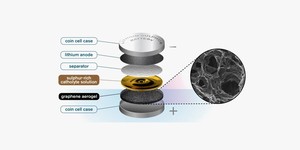Researchers unveil graphene-based cooling film
July 10, 2015 | 11:34
Companies: #chalmers-university #research

Researches from the Chalmers University of Technology have announced a novel method for cooling electronics, using a film of wonder-material graphene.
Published in the Advanced Functional Materials jounal as Improved Heat Spreading Performance of Functionalized Graphene in Microelectronic Device Application, the team's research - carried out in collaboration with researchers at Shanghai University, Ecole Centrale Paris, EM2C CNRS, and Smart High Tech in Sweden - builds on work done two years ago demonstrating that graphene, an allotrope of carbon constructed in a honeycomb lattice just one atom thick, could be used to cool electronics efficiently.
'The methods that have been in place so far have presented the researchers with problems,' explained project lead Johan Liu. 'It has become evident that those methods cannot be used to rid electronic devices off great amounts of heat, because they have consisted only of a few layers of thermal conductive atoms. When you try to add more layers of graphene, another problem arises, a problem with adhesiveness. After having increased the amount of layers, the graphene no longer will adhere to the surface, since the adhesion is held together only by weak van der Waals bonds.
'[i]We have now solved this problem by managing to create strong covalent bonds between the graphene film and the surface,' crowed Liu, 'which is an electronic component made of silicon..' This breakthrough, the paper explains, is the result of graphene functionalisation: the addition of a property-altering molecule to make graphene more useful, in this case (3-Aminopropyl) triethoxysilane. When heated and put through the process of hydrolysis, the additive creates strong silane bonds between the graphene and the electronic component to be cooled. As an added advantage, it doubles the thermal conductivity of the graphene - leading to a 20 micrometer-thick film boasting thermal conductivity of 1600W/mK, four times that of copper.
'Increased thermal capacity could lead to several new applications for graphene,' Liu claimed. 'One example is the integration of graphene-based film into microelectronic devices and systems, such as highly efficient Light Emitting Diodes (LEDs), lasers and radio frequency components for cooling purposes. Graphene-based film could also pave the way for faster, smaller, more energy efficient, sustainable high power electronics.'
No timescale has been provided for commercialisation of the new material.
Published in the Advanced Functional Materials jounal as Improved Heat Spreading Performance of Functionalized Graphene in Microelectronic Device Application, the team's research - carried out in collaboration with researchers at Shanghai University, Ecole Centrale Paris, EM2C CNRS, and Smart High Tech in Sweden - builds on work done two years ago demonstrating that graphene, an allotrope of carbon constructed in a honeycomb lattice just one atom thick, could be used to cool electronics efficiently.
'The methods that have been in place so far have presented the researchers with problems,' explained project lead Johan Liu. 'It has become evident that those methods cannot be used to rid electronic devices off great amounts of heat, because they have consisted only of a few layers of thermal conductive atoms. When you try to add more layers of graphene, another problem arises, a problem with adhesiveness. After having increased the amount of layers, the graphene no longer will adhere to the surface, since the adhesion is held together only by weak van der Waals bonds.
'[i]We have now solved this problem by managing to create strong covalent bonds between the graphene film and the surface,' crowed Liu, 'which is an electronic component made of silicon..' This breakthrough, the paper explains, is the result of graphene functionalisation: the addition of a property-altering molecule to make graphene more useful, in this case (3-Aminopropyl) triethoxysilane. When heated and put through the process of hydrolysis, the additive creates strong silane bonds between the graphene and the electronic component to be cooled. As an added advantage, it doubles the thermal conductivity of the graphene - leading to a 20 micrometer-thick film boasting thermal conductivity of 1600W/mK, four times that of copper.
'Increased thermal capacity could lead to several new applications for graphene,' Liu claimed. 'One example is the integration of graphene-based film into microelectronic devices and systems, such as highly efficient Light Emitting Diodes (LEDs), lasers and radio frequency components for cooling purposes. Graphene-based film could also pave the way for faster, smaller, more energy efficient, sustainable high power electronics.'
No timescale has been provided for commercialisation of the new material.

MSI MPG Velox 100R Chassis Review
October 14 2021 | 15:04








Want to comment? Please log in.